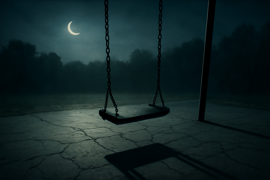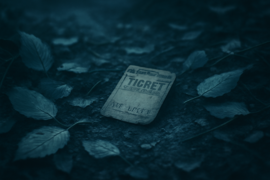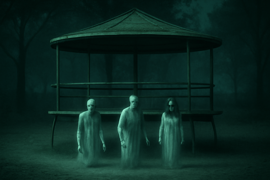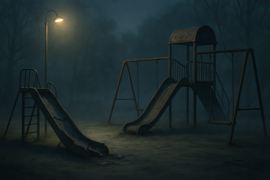Introduction
The first time Mara Blake heard the myth of Huntsville’s abandoned playground, she was chasing down a rumor as part of her live investigative blog series on forgotten legends. Friends warned her against it—howling winds, sudden cold spots, and laughter echoing through rusted swings long after sunset. Intrigued by the tangled threads of local tragedy and whispered hauntings, Mara arrived at dusk. The sky was bruised purple above the skeletal remains of swings and slides, their once-vibrant paint peeling like dried tears. Every creak of metal sent a jolt through her, and each fallen leaf skittering across cracked pavement felt like a shy child darting just beyond sight. Distant street lamps cast elongated shadows, making playground equipment seem like restless sentinels watching her every move. She set up her camera near the tallest slide, its lip stained with unnatural dark splotches rumored to be the result of that fateful night fifty years ago when a carnival bus crashed, killing a group of children on their way home. In the hush before midnight, she could almost hear faint giggles carried on a breeze too cold for October. Her heart pounded with equal parts dread and determination. She tapped her mic, determined to see whether this legend would unravel under her lens—or whether those lost voices would finally be set free.
Echoes in the Swing Set
Nobody truly expected that beyond the gate of chalk-dusted bricks, a playground could remember. On Mara’s first night, she sat beneath the highest swing beam and pressed record. The wind rattled chains overhead like ghostly fingers drumming out a secret code. Each time the beam creaked, Mara’s pulse spiked, as if the swings themselves were calling out: come closer, listen harder. She shined her flashlight across the worn rubber seats, noting gouges rumored to match the scalloped hem of a child’s dress—and wondered whether that dress might still cling to the shadows. A chill breeze brushed her neck, and she turned, expecting to see someone standing behind her. Nothing, except her own reflection in the lens. Then, faint laughter drifted around a corner, soft and irregular, as though a small child hesitated before each peal. Mara rose, following the sound past a half-collapsed jungle gym, her flashlight tranche carving through the gloom. The laughter stopped abruptly. In the silence, she found tiny footprints in the dust—no larger than a toddler’s, and only one set, leading toward the slide.

She climbed the slide gingerly, heart hammering. At the top, she discovered a single red balloon tethered to the railing, its ribbon frayed. It bobbed silently, as though waiting. Mara’s breath visibly fogged in the sudden drop of temperature, and her camera’s night-vision flickered, revealing a faint silhouette near the bottom. She called out, voice trembling, “Hello?” The silhouette vanished. As she descended, the friction of her jacket against the rusted steel raised a shrill screech that echoed like a funeral dirge. It sounded so agonized she felt a tremor in her chest. Mara backed away from the slide, but steel springs began to squeal behind her, and she spun around. The swings were in motion, though the air was still. One seat swayed slowly, almost imperceptibly, then jerked back and forth in a frantic rhythm, stirring leaves in its wake. Those giggles returned, fractured and distant, as if the playground itself had come alive to join in a hollow chorus.
In the final quarter hour before dawn, Mara discovered the heart of the tragedy: near the sandbox lay a rusted carnival ticket stub, yellowed and brittle. The date printed on it matched the night of the bus crash: October 15th, 1973. She stumbled back to her equipment, replayed her audio, and heard faint whispers calling out names: “Ella…Aaron…Claire…” Names of children who vanished with that bus. Each syllable was wrapped in an unbearable sadness that seeped through the speakers and froze her blood. Compelled, she extended her hand to the ticket stub, and for fleeting seconds she saw a cluster of small figures around her—colorless apparitions with hollow eyes, reaching upward as if longing to be remembered. They flickered and dissolved into the morning mist. In the hush that followed, the park grew quiet, and Mara realized she was alone again. Yet she could not erase the weight of those names murmured in her mind. The ghosts of Huntsville’s young riders were not at rest.
Whispers After Dusk
As twilight surrendered to night, Mara prepared for her second vigil. Armed with infrared cameras and sensitive audio mics, she charted every inch of the playground. The relics of that tragic evening were strewn among broken slides and twisted monkey bars: a tarnished wristwatch half-buried in the mud, a child’s lost shoe with frayed laces, and a faded photograph stuck inside a hollow tree stump. She paused at each relic, whispering apologies into the rail-thin quiet. No one answered—until flickers of movement danced in her peripheral vision. Shadows twisted around the base of a climbing frame like ink spreading through water. She aimed her camera; the footage revealed pale figures darting between beams before disappearing as suddenly as they appeared.

The wind changed, turning bitter cold, and the perimeter lights around the lot died with a final crackle. In the semi-darkness, Mara glimpsed a shape crouched near the slide’s exit ramp. When she approached, she found a small journal sealed by time. Opening it, she read a child’s sprawling scrawl, each entry capturing dreams of carnival rides, laughter among friends, and a promise to return tomorrow. The final page was smudged with tears and ended mid-sentence. It pained her to imagine the abrupt cut when life ceased. Holding the journal, she felt the weight of countless unseen eyes watching. Goosebumps climbed her arms as a child’s voice echoed: “Why did you forget us?” She spun around, but only the reflected shine of broken playground glass greeted her. Yet that single question rang in her ears all night.
By midnight, the journal’s pages glowed faintly under the infrared lamp, as though responding to her presence. The laughter returned—this time clearer, like children chasing one another, their footsteps pounding through cracked asphalt. Mara chased the sound to a cluster of swing chains that began to clank in unison. She shone her torch between the seats and saw a small handprint scrawled in dust on the nearest swing: five tiny fingers curled like a desperate plea. She reached out to touch it, and the air around her convulsed with a chilling scream. The ground trembled, and the outline of a child’s figure formed in mist just beyond her lens. It flickered, and for a moment its features resolved into those from the photograph she’d found earlier—eyes wide with fear and lips mouthing, “Help us.” A final gust extinguished her light. In the enveloping darkness, Mara whispered vows to carry their stories beyond the playground gates.
When dawn’s gentle haze washed the sky, Mara emerged—shaken, yet determined. She packed her gear, leaving behind the journal where she found it, now closed and peaceful. As she walked away, she glanced back to see the swings still, the slide empty, and the broken games silent. But in the soft morning glow, she caught sight of chalked letters scrawled near the entrance: “Remember us.”
Confronting the Mourning Spirit
Mara returned for one final night, convinced that only by confronting the spirit directly could the restless echoes find peace. She set up an elaborate array of equipment: thermal sensors tracing every temperature fluctuation, EMF readers to capture surges of electrical energy, and an array of cameras to record every angle. As darkness swallowed the playground, she felt the familiar prickle of unseen eyes following her. She called out softly into the gloom, “I’ve come to help. Tell me what you need.” For a moment, all was still. Then the swings sang to life, moving in slow, deliberate arcs. A deep chime echoed across the yard—the sound of a carnival calliope long rusted, now resurrected in spectral harmony.

Guided by the chime, Mara approached the carousel horse carved into a bench near the slide’s base. Its hoof was chipped, and its painted eye betrayed a knowing look. EMF gauges flickered wildly as she brushed her hand over the horse’s mane. In the faint luminescence of her night-vision, spectral tendrils seeped from cracks in the bench, twisting upward like mournful smoke. Mara spoke the names etched in the journal—Ella, Aaron, Claire—slowly, reverently. One by one, the air condensed into shapes: a small girl with a crooked smile, a boy clutching a battered teddy bear, a teenage girl whose hair floated as though underwater. Their voices coalesced into a single, quivering plea, “We can’t move on.” Tears welled in Mara’s eyes as she knelt before them, promising remembrance and truth.
She produced a hastily prepared memorial plaque, reading the names of every child lost in the bus crash, and gently pressed it against the worn ground. A wind gusted through the playground, swirling leaves into a soft halo of color. The tension that had lodged in the air since twilight dissipated in a long, sorrowful sigh. One by one, the figures faded, smiling in relief as they ascended into the night sky, leaving behind a single rose petal. Mara collected it, feeling its fragile warmth despite the chill. The swings came to rest, and the playground fell silent—no more laughter, no more cries. Only the gentle rustle of leaves and the soft assertion of dawn.
When she finally stepped beyond the gate at sunrise, Mara knew the playground had changed. The once-ominous equipment now looked peaceful in morning light, as though aged sorrow had been transformed into a quiet vigil. Back home, she shared every recording, every photograph, and the delicate rose petal pressed within her notebook. Through her story, the children of Huntsville would never be forgotten—and the playground, now cleared of its grief, would stand as a testament to the power of remembrance.
Conclusion
As the sun climbed higher on Mara’s final morning, the playground of Huntsville no longer seemed haunted but hallowed. The echoing laughter had been replaced by wind through the trees, and the creak of metal had quieted into an almost reverent hush. Mara understood then that the most restless spirits weren’t driven by malice, but by the ache of being forgotten. By bringing their stories into the light—replaying their names, recounting each detail of that tragic October night—she wove a new legacy for the children lost to history. The rusted swings, once vessels of sorrow, now stood as silent witnesses to a promise kept: that loss would not be erased but honored.
Her recordings and photographs spread through Huntsville and beyond, reigniting empathy for forgotten tragedies. Neighbors who once crossed the street to avoid the gates now lingered at dawn, laying fresh flowers and whispering quiet prayers. Mara’s blog post went viral, not for sensationalism, but because it tapped into something universal: the human need to remember and to grieve together. In the heart of that reclaimed playground, laughter returned—soft and tentative at first, then hearty as families reclaimed the space. And on nights when the moon was full, a faint chorus of children’s voices could still be heard, not as cries of despair, but as gentle affirmations that though life may end, remembrance endures. Mara left Huntsville changed, carrying with her a simple truth: the dead may wander, but their peace lies in being remembered with love and care, echoing through the world long after their voices fall silent.


















